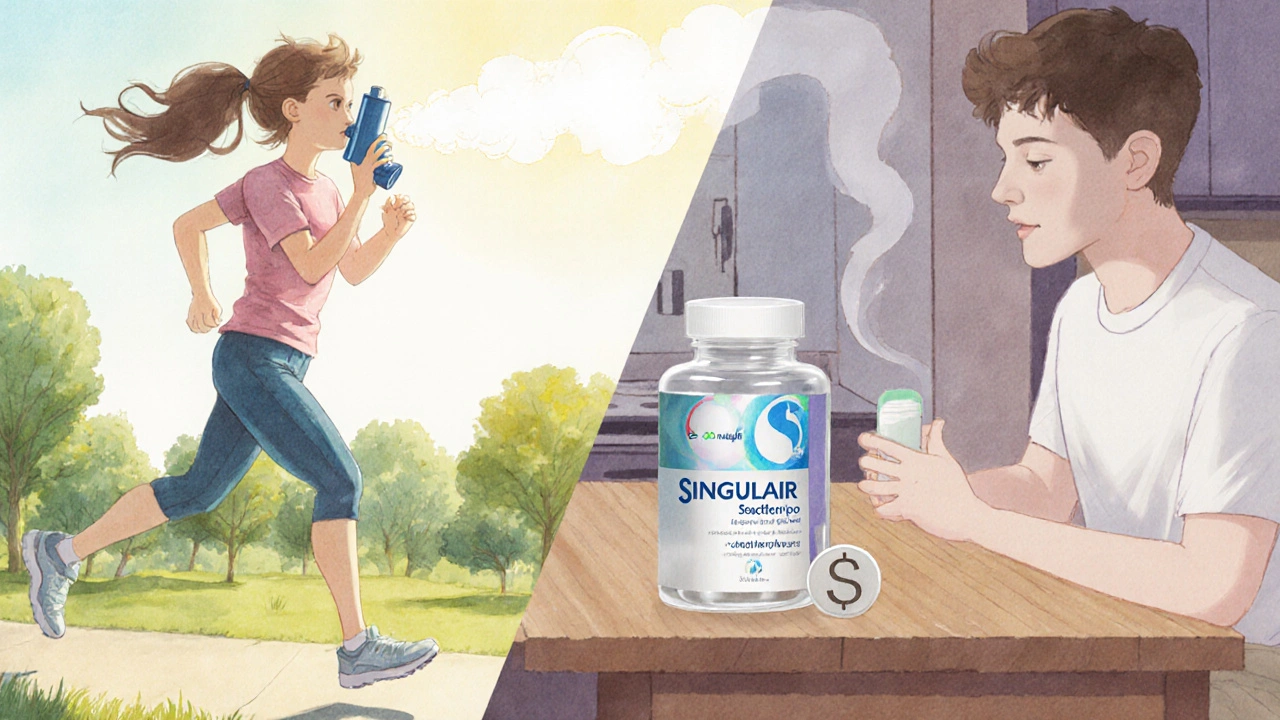Singulair (Montelukast) vs. Top Alternatives: Benefits, Risks, and Choosing the Best Option

- Colin Hurd
- 29 September 2025
- 13 Comments
Medication Choice Advisor
Step 1: Identify Your Primary Problem
Step 2: Rate Severity
Step 3: Delivery Preference
Step 4: Any Contraindications?
Your Recommended Medication
When it comes to managing asthma or seasonal allergies, many Australians reach for Montelukast - the active ingredient behind the brand name Singulair. It’s praised for its once‑daily oral dose and its ability to reduce inflammation caused by leukotrienes. But you’re not alone if you’ve wondered whether there’s a better fit for your symptoms, budget, or lifestyle. Below we break down how Singulair stacks up against the most common alternatives, so you can decide if a switch makes sense before you talk to your GP or pharmacist.
Key Takeaways
- Singulair blocks leukotrienes, helping with asthma, allergic rhinitis, and exercise‑induced bronchoconstriction.
- Alternatives include other leukotriene blockers, inhaled steroids, antihistamines, cromolyn, biologics, and allergen immunotherapy.
- Side‑effect profiles differ: Montelukast has rare neuropsychiatric warnings, while steroids can cause oral thrush and antihistamines may cause drowsiness.
- Cost and insurance coverage vary - generic Montelukast is cheap, biologics are expensive, and some nasal sprays are bulk‑priced.
- Choosing the right option depends on severity, trigger type, age, and how quickly you need relief.
How Montelukast Works
Montelukast belongs to the class of leukotriene receptor antagonists. Leukotrienes are chemicals released during an allergic reaction that cause airway tightening, mucus production, and inflammation. By blocking the cysteinyl‑leukotriene receptor (CysLT1), Montelukast reduces these effects, leading to smoother breathing and fewer night‑time coughs. It’s taken as a 10mg tablet for adults, with pediatric doses of 4‑5mg for children aged 2‑14.
When to Consider an Alternative
Even though Montelukast works well for many, there are scenarios where a different approach may be advisable:
- Persistent night‑time symptoms despite regular use.
- Concerns about rare mood changes, depression, or suicidal thoughts linked to Montelukast.
- Need for faster relief during an acute asthma flare - leukotriene blockers are not rescue meds.
- Preference for inhaled or topical delivery instead of a daily pill.
- Specific insurance formularies that favor other drug classes.

Top Alternatives Overview
Below is a quick snapshot of the five most common categories that doctors turn to when Singulair isn’t the best fit.
1. Zafirlukast - Another Leukotriene Blocker
Zafirlukast is a sibling drug to Montelukast, also blocking CysLT1 receptors. It’s taken twice daily, which some patients find less convenient. Its side‑effect profile mirrors Montelukast, but it can cause liver enzyme elevation, so routine blood tests are recommended.
2. Inhaled Corticosteroids (ICS) - Fluticasone and Budesonide
Fluticasone (often delivered as a nasal spray or inhaler) and Budesonide are potent anti‑inflammatory agents. They act directly on airway tissue to suppress the immune response. While very effective for chronic asthma control, they require proper inhaler technique and can cause oral thrush or hoarseness.
3. Oral Antihistamines - Loratadine and Cetirizine
Loratadine and Cetirizine block histamine receptors, easing sneezing, itching, and watery eyes. They’re handy for allergic rhinitis but don’t address bronchoconstriction, so they’re usually paired with a bronchodilator for asthma patients.
4. Cromolyn Sodium - Mast Cell Stabilizer
Cromolyn sodium is inhaled via a nebulizer or metered‑dose inhaler. It prevents mast cells from releasing histamine and leukotrienes in the first place. Effectiveness is modest, and multiple daily doses are needed, limiting its popularity.
5. Biologic Therapy - Omalizumab
Omalizumab is an injectable monoclonal antibody that binds IgE, the antibody that drives allergic inflammation. It’s reserved for severe allergic asthma that doesn’t respond to standard inhalers. The price tag is high, and patients must receive monthly subcutaneous shots.
6. Allergen Immunotherapy - SLIT and SCIT
Allergen immunotherapy involves exposing patients to gradually increasing amounts of the offending allergen, either as sublingual tablets (SLIT) or injections (SCIT). Over years, the immune system builds tolerance, reducing reliance on daily medication. It’s a long‑term commitment and requires specialist supervision.
Side‑Effect Comparison
| Alternative | Drug Class | Common Side Effects | Serious Risks |
|---|---|---|---|
| Montelukast (Singulair) | Leukotriene receptor antagonist | Headache, stomach upset | Rare neuropsychiatric events (depression, suicidal thoughts) |
| Zafirlukast | Leukotriene receptor antagonist | Nausea, dizziness | Liver enzyme elevation, same neuropsychiatric warnings |
| Fluticasone / Budesonide | Inhaled corticosteroid | Oral thrush, hoarseness | Potential growth suppression in children (high doses) |
| Loratadine / Cetirizine | Second‑generation antihistamine | Dry mouth, mild drowsiness (cetirizine) | Rare cardiac rhythm changes at high doses |
| Cromolyn sodium | Mast cell stabilizer | Cough, throat irritation | Minimal serious risks |
| Omalizumab | Anti‑IgE biologic | Injection site reaction, headache | Anaphylaxis (very rare), high cost |
Decision Guide: Picking the Right Therapy
Think of medication choice as a balancing act between symptom control, side‑effect tolerance, convenience, and cost. Use the checklist below to narrow down the best fit for you or your child:
- Identify the primary problem. Is it nighttime asthma, exercise‑triggered wheeze, or persistent hay‑fever?
- Rate severity. Mild‑to‑moderate symptoms often respond to oral antihistamines or a single inhaled steroid. Severe or uncontrolled cases may need a leukotriene blocker or biologic.
- Consider delivery preferences. Some people dislike daily pills (choose inhaled or nasal spray). Others struggle with inhaler technique (oral meds might be easier).
- Check for contraindications. Liver disease - avoid Zafirlukast. History of depression - discuss risks of Montelukast. Pregnancy - many antihistamines are category B.
- Review cost and insurance. Generic Montelukast is usually under $10 a month in Australia. Biologics can exceed $2,000 per dose; check PBS listing.
When you line up the answers, you’ll see whether Singulair alternatives actually improve your quality of life or simply add another pill to the cabinet.
Frequently Asked Questions
Can I take Montelukast with an inhaled steroid?
Yes. Combining a leukotriene blocker like Montelukast with an inhaled corticosteroid often provides better asthma control than either medication alone, especially for nighttime symptoms.
Are there any natural supplements that work as well as Singulair?
While omega‑3 fatty acids, quercetin, and butterbur have modest anti‑inflammatory effects, none have been proven to match the clinical efficacy of Montelukast for asthma or exercise‑induced bronchoconstriction.
Is Zafirlukast still prescribed in Australia?
Zafirlukast is available but used less often because Montelukast’s once‑daily dosing is more convenient. Some specialists prescribe it when a patient experiences liver‑related side effects on Montelukast.
What should I do if I experience mood changes on Singulair?
Contact your GP right away. They may pause Montelukast and switch you to an inhaled steroid or another leukotriene blocker. Monitoring tools like the PHQ‑9 questionnaire can help track symptoms.
Can children use Omalizumab?
Yes, Omalizumab is approved for children aged six and older with severe allergic asthma that isn’t controlled by high‑dose inhaled steroids. It requires specialist referral and regular monitoring.




Comments
Mara Mara
I appreciate the thorough breakdown; however, the Australian context doesn't translate directly to us here in the States-especially when considering insurance formularies, prescription costs, and the prevalent reliance on inhaled corticosteroids. The piece does a solid job covering mechanisms, yet it could have highlighted how the PBS listings differ from our Medicare coverage. Also, the emphasis on nightly dosing cues me to think about adherence challenges faced by patients juggling multiple meds. Overall, great effort, but a few more US‑specific references would make it truly universal.
September 29, 2025 AT 12:42
Abhishek Vernekar
Your point about insurance is spot‑on; many readers overlook the financial barriers that shape treatment choices. By emphasizing the clinical data while also noting real‑world accessibility, you give a balanced view that’s both scientifically accurate and empathetically grounded. Keep up the precise, friendly tone-it makes the complex subject feel approachable.
October 2, 2025 AT 06:40
Val Vaden
Not bad, but I still think more focus on the side‑effects would help. The table is useful :)
October 5, 2025 AT 01:20
Leonard Greenhall
The side‑effect table is concise, yet it omits the incidence rates that clinicians rely on when weighing risk versus benefit. For instance, neuropsychiatric events with Montelukast, although rare, have a reported prevalence that guides monitoring protocols. Additionally, the discussion could benefit from a brief mention of drug‑drug interaction potential, especially for patients on polypharmacy regimens.
October 7, 2025 AT 18:36
Abigail Brown
Reading through this guide feels like embarking on a journey through the intricate landscape of respiratory therapy, where each fork in the road presents a new possibility for relief. The narrative begins by honoring the simplicity of Montelukast, a once‑daily pill that promises to tame nocturnal wheezing with a single swallow. Yet, as the text unfolds, it wisely reminds us that no single medication can claim universal supremacy.
Consider the patient who awakens each night gasping for air; for them, the inhaled corticosteroid may serve as a steadfast guardian, delivering anti‑inflammatory power directly to the bronchial walls. In contrast, the individual plagued by seasonal sneezes and itchy eyes might find solace in an antihistamine, whose swift action calms histamine storms without the need for inhalation techniques.
The exploration of Zafirlukast introduces a subtle nuance: a twice‑daily regimen that, while less convenient, could suit those whose metabolism processes the drug more effectively. Meanwhile, the mention of biologics such as Omalizumab beckons the reader toward cutting‑edge therapy, reserved for the most recalcitrant cases where traditional inhalers falter.
One cannot overlook the economic dimensions either; a generic Montelukast tablet often costs a fraction of a biologic’s monthly fee, yet the latter’s long‑term efficacy may offset its price for severe asthmatics. The guide also touches upon the psychological shadows cast by Montelukast, acknowledging the rare but serious mood disturbances that compel clinicians to monitor patients closely.
In the end, the decision matrix presented here is not a rigid formula but a compassionate invitation to personalize care. It urges us to weigh severity, delivery preference, comorbidities, and even lifestyle quirks before committing to a regimen. Such a holistic approach embodies the very spirit of patient‑centered medicine, reminding us that the best drug is the one that fits seamlessly into a person’s daily life while delivering consistent, safe control of their symptoms.
October 10, 2025 AT 14:40
Scott Swanson
Oh great, another “choose your own adventure” that pretends it’s not a sales pitch for pharma. If you enjoy being told which pill to pop based on a flowchart, keep scrolling; otherwise, maybe ask your doctor for real advice.
October 13, 2025 AT 07:56
Karen Gizelle
Honestly, it's disheartening to see how some people blindly follow the latest drug hype without even considering the moral implication of supporting big pharmaceutic corpora tions. We need to be more vigilant and demand transparency.
October 16, 2025 AT 01:13
Stephanie Watkins
The analysis you provided is thorough and respects the nuances of each therapeutic option. It maintains a balanced perspective while encouraging readers to seek personalized medical counsel.
October 18, 2025 AT 18:30
Zachary Endres
Great job laying out the alternatives; it’s reassuring to see both the pros and cons side by side. This kind of clear information empowers patients to make confident choices.
October 21, 2025 AT 11:46
Will Esguerra
While the article admirably enumerates the pharmacologic spectrum, it neglects to address the profound psychosocial dimensions that accompany chronic respiratory disease-namely, the stigma attached to inhaler use in public spaces, the anxiety triggered by unpredictable flare‑ups, and the socioeconomic barriers that restrict access to advanced biologic therapies. A truly comprehensive guide must integrate these human factors alongside biochemical mechanisms.
October 24, 2025 AT 05:03
Allison Marruffo
This guide is a solid resource; the clear tables and step‑by‑step approach make complex information easy to digest. I especially appreciate the emphasis on consulting healthcare professionals before making changes.
October 26, 2025 AT 21:20
Ian Frith
From a clinical standpoint, the inclusion of both pharmacologic and non‑pharmacologic strategies creates a well‑rounded picture of asthma management. The discussion of leukotriene antagonists alongside inhaled corticosteroids mirrors current guideline recommendations, and the cautionary notes about neuropsychiatric effects are spot‑on for safe prescribing.
October 29, 2025 AT 14:36
Beauty & Nail Care dublin2
Wow, this really opened my eyes! 🌟👀
October 31, 2025 AT 04:06